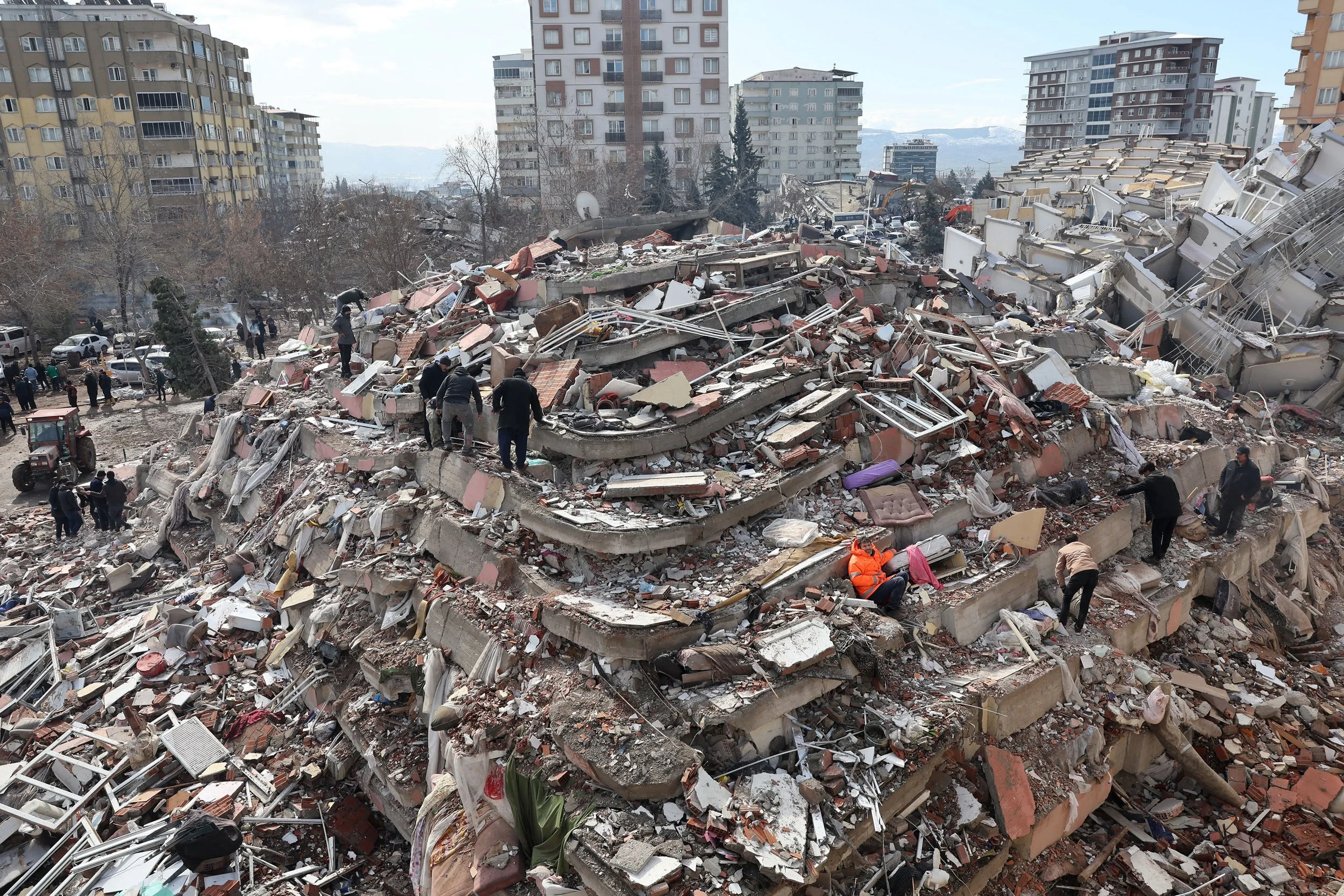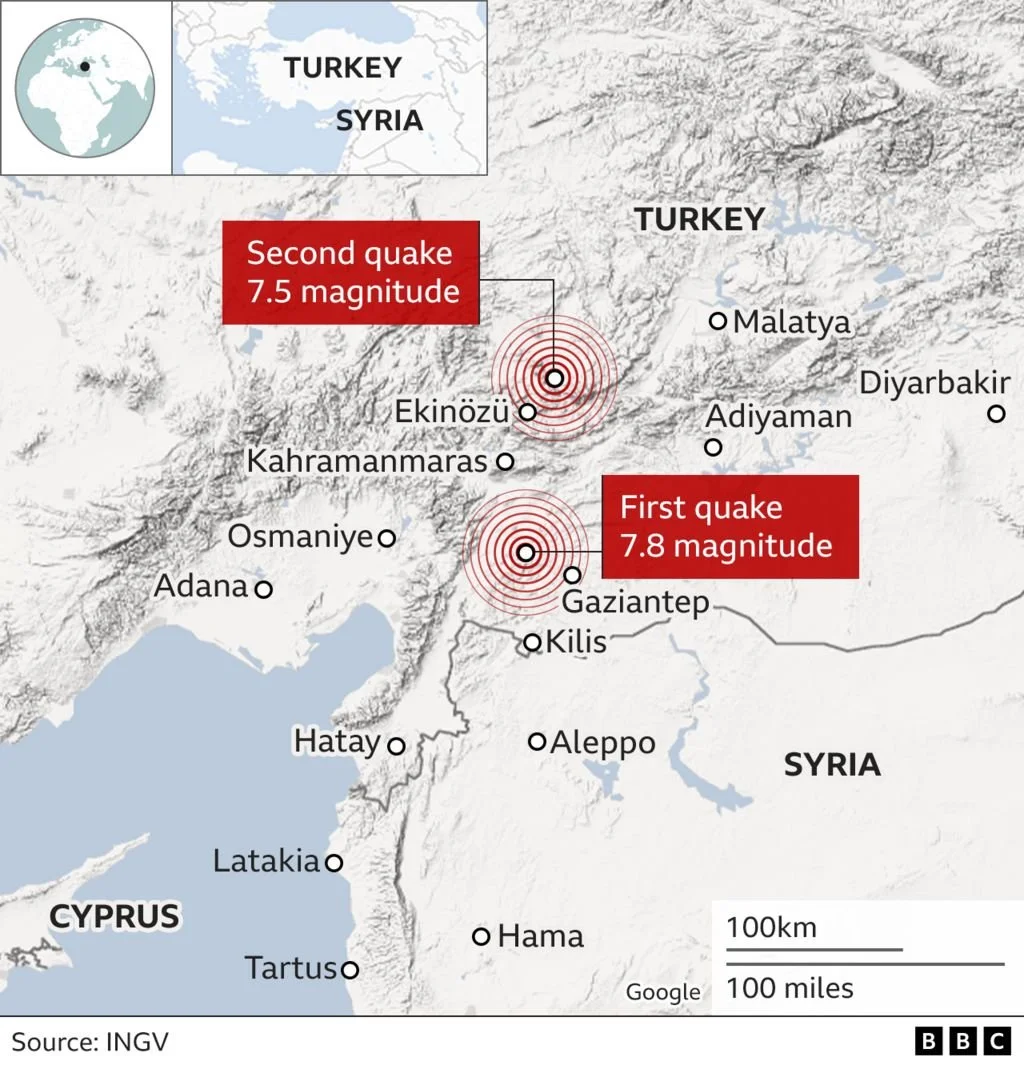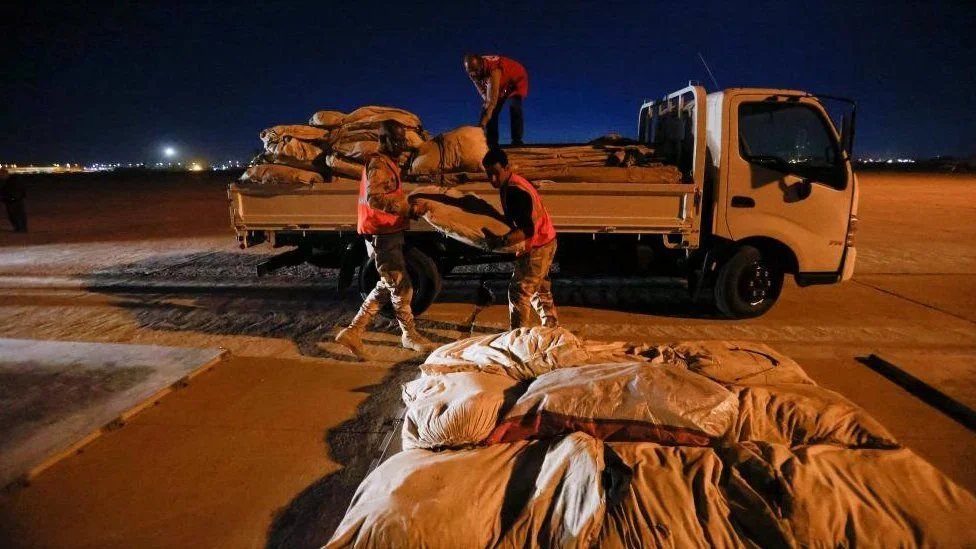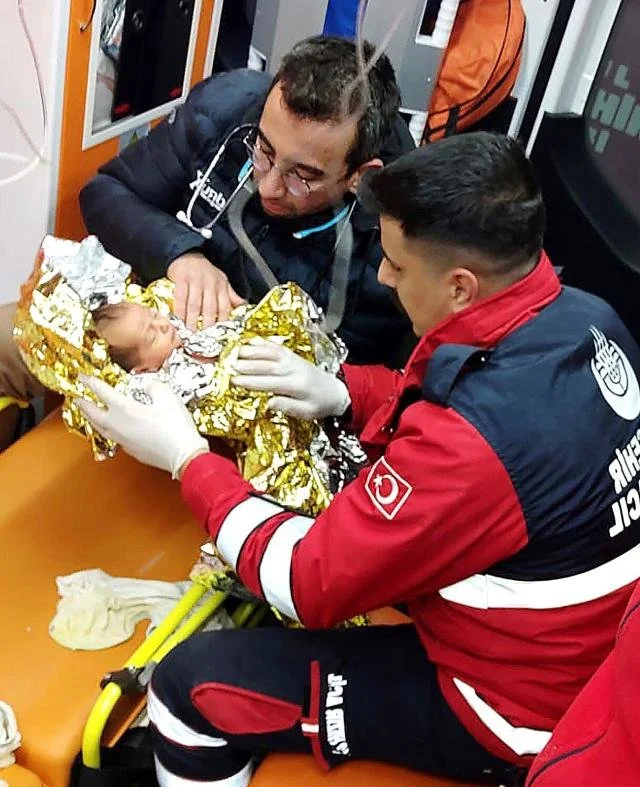Tragedy and Temblors: Relief Efforts in Turkey and Syria
Civilians look for survivors under the rubble of collapsed buildings in Kahramanmaras, close to the quake’s epicentre, the day after a 7.8-magnitude earthquake struck the country’s southeast, on February 7, 2023. Adem Altan | AFP | Getty Images
The morning of February 6th was peaceful. The twilight sky was still dark, but stars were slowly becoming less visible. Residents were waking up little by little to get ready for work and start their day. But at around six o’clock in the morning, the ground shook and everyone who was sleeping in northern Syria and southern Turkey were awoken by an massive earthquake that would record a 7.8 on the Richter Scale. It would be felt in Lebanon, Israel and even parts of Iran. Around 60 aftershocks would occur with the biggest one having a magnitude of 7.5 following the initial quake. This aftershock was just 50 miles from the epicenter, with all following aftershocks reaching 200 miles out from the initial epicenter. Turkey had had several large magnitude earthquakes over the years, but the quake that shook Turkey’s Gaziantep region was tied with the nation's largest earthquake in 1939.
A map of the two earthquakes that struck Southern Turkey and Northern Syria, and their respective magnitudes on the Richter Scale.
The weather played against those affected with very cold temperatures around this time of year in the affected areas. To make matters worse, CNN meteorologists reported a very severe storm that swept across the country. Temperatures could hit freezing. This storm will affect incoming aid and further deepen the suffering of the victims. Food will be harder to come by due to the destruction of crops. People in Syria were already grappling with outbreaks of cholera, which causes abdominal pain, diarrhea, and extreme nausea. According to the World Health Organization, cholera can kill within hours if not properly treated. Cholera is rampant when there is a lack of safe, drinkable water and contaminated food. The outbreak has been made worse due to the destruction of the earthquake, further making it difficult to find safe food and water.
Since the initial hit, countries have flooded aid to those suffering in Syria and Turkey. Those most affected by the quake are women and children, with many families being displaced and left homeless. They are the most vulnerable amongst those affected. Aid from Iraq and Iran arrived on the Monday of the quake and the next morning. According to an official from the Iraqi Ministry of Foreign Affairs, the planes held over 70 tons of food, medical supplies, and more. Iraqi Prime Minister Mohammed S. Al-Sudani declared more aid, as well as Iran’s Foreign Minister, Hossein Amir-Abdollahian, who promised help to his Syrian counterpart. Looking outside the Middle East, Japan’s Disaster Relief Rescue Team was dispatched for search efforts. Within the United States, the Los Angeles County Fire Department sent over their own Urban Search and Rescue Team with 78 members. They did not travel alone, as Virginia Task Force 1 sent over just about the same amount of crew members. The Médecins Sans Frontières or Doctors Without Borders dispatched teams to northern Syria, but sadly they are also suffering from the earthquake with the deaths of members and family members.
Iraqi soldiers and the Iraqi Red Crescent society workers loaded trucks with the materials going to the disaster zone. Credit: Reuters
With seemingly no end in sight, relief efforts and any hope of possible reconstruction were struck down with the eruption of a new earthquake just a few weeks after the 7.8 magnitude one that devastated northern Syria and southern Turkey. Prior to the second major quake, the damage and death toll was immense. More than 50,000 people have died with around one million people displaced and homeless and these numbers are made worse with the second quake weeks later. Over 236,000 buildings have collapsed trapping a large number of people under them, making rescue efforts almost impossible. One hopeful story is that of a newborn baby named Afraa, named after her mother who passed away in the earthquake. She was born during the earthquake and when found she was named Aya, or ‘miracle’ in Arabic. She was under a building for over 10 hours and was in poor condition when taken to seek medical help. Along with the death of her mother, Afraa has also lost her father, four siblings, and her aunt. However on a happier note, she is healthy and now with her aunt and uncle who have happily decided to take her in and care for her. Her aunt and uncle also have a newborn girl that was born after the earthquake. Another happy story is that of a family with a twelve year old son that was rescued over 296 hours after the initial earthquake.
Following stories for celebration amidst tragedy, a ten day old baby with the name of Yağız Ulaş was rescued with his mother almost four days after the February 6th quake. Due to the severe damage, there were many others trapped underneath rubble. 17 year old Adnan Muhammed Korkut, was rescued from a basement for more time than newborn Yağız Ulaş. Korkut was reunited with family and his mother once he was rescued. To respond to the victims and their families, Turkey’s president, Recep Tayyip Erdogan, has promised that search and rescue efforts would not end until everyone is found. In addition to this, the president has promised rental assistance to earthquake victims for the next year.
Istanbul Metropolitan Municipality / Handout/Anadolu Agency via Getty: The newborn was rescued along with his mother after 4 days underneath rubble and debris.
With the eruption of a new large earthquake on February 20th recording a 6.4 magnitude, many people have been devastated worse. Between the original quake and the second, there have been over 6000 aftershocks. Due to the constant tremors, people have become trapped under buildings once again because they believed homes or other buildings were safe post-earthquake. Those who fared better were those sleeping in tents in encampments put up or those who took shelter in their cars out of fear. Syrian people were harmed and hospitalized because of stampedes that occurred due to fear from the eruption. There was fear of a possible tsunami and the disaster management team in Turkey advised residents to avoid the coast. As a result, many residents of coastal cities fled inland. The second quake is not helping efforts to find safe shelter for those affected. British diplomat, Martin Griffiths, told the United Nations about the high-risk buildings that are still standing and those that need to be demolished to secure the area. One Turkish lawmaker stated that people should no longer step foot in any buildings and will temporarily be only staying in tents. There must be taken into consideration the lack of facilities to house those with disabilities and other special conditions like chronic illnesses.
The earthquake has made the humanitarian crisis in these countries worse. Griffiths spoke to the United Nations about the crisis in Syria the most. Pre-earthquake over 70% of Syria’s population needed humanitarian aid. The United Nations is planning to send aid to Syrian victims through a flash appeal of over $397.6 million dollars and is almost halfway funded. Contrast this to an appeal to $1 billion for Turkey. Damages caused by both major earthquakes are estimated to be over $34.2 billion dollars according to a report from the World Bank. Worse than this, the report states that costs for reconstruction will be exponentially more expensive.
Earthquake relief efforts have been made more difficult with the ongoing civil crisis in Syria. Right after the February 6th earthquake, Bab al-Hawa, the only line of transportation from the United Nations into Syria, has been damaged due to the quake. The crossing has been the only way for aid to come to Syria from the United Nations during Syria’s civil war. The damage from neighboring roads has prevented aid from entering Syria from Turkey in the days following the first major quake, but have now been fixed. Over 100 trucks from the United Nations have gone through the crossing. Late Syrian refugees who passed in Turkey were returned home. Refugees suffered so much during the civil war as victims of airstrikes and shelling. In total, there have been over four million Syrians who have seeked refuge in Turkey to escape the war.
Syrian Civil Defense workers and security forces search through the wreckage of collapsed buildings after a devastating earthquake rocked Syria and Turkey, in Aleppo, Syria, Monday, Feb. 6, 2023. Credit: (AP Photo/Omar Sanadiki, File)
In a change of events, the Turkish government has agreed to let Syrian refugees return to Syria for three to six months before having to return back to Turkey. This was announced to allow Turkey to get a firm grasp on relief efforts and rebuilding in a post-earthquake country. However, there isn't much hope for a Syria that is faring better than Turkey after the two earthquakes. The damage is worse in Turkey, but Syria has its own struggles with visible signs of war. There are understandable worries from residents that Turkey may decide to revoke its decision and leave them stranded in Syria all over again. Despite the fear, thousands of people have made their way to the biggest border crossing, Bab Al-Hawa, and a few other smaller ones spread between the two countries. Over the years, Turkey has run a tight ship in regards to border control with over 3.7 million Syrian refugees already living in the country.
With the unexpected nature of an earthquake, there is virtually no way to prepare for such a natural disaster. The intensity of earthquakes are unpredictable and the aftermath is even worse. As shown with this earthquake and its extremity, it affected a large number of people, a chunk of those people already dealing with poor circumstances. War-torn Syria did not need the added stress to deal with. Now split up families have to worry about their counterparts on the other side of the border. Residents in Turkey are displaced from their homes and dealing with loss due to the tremors. Aid from all over the world shows compassion and sympathy for those in dire times despite any possible preceding conflicts. It is a case for the existence of our shared humanity and the efforts put in by those who wish to maintain this humanity when it is slowly being destroyed.
Edited by Dimitri Zlatev





